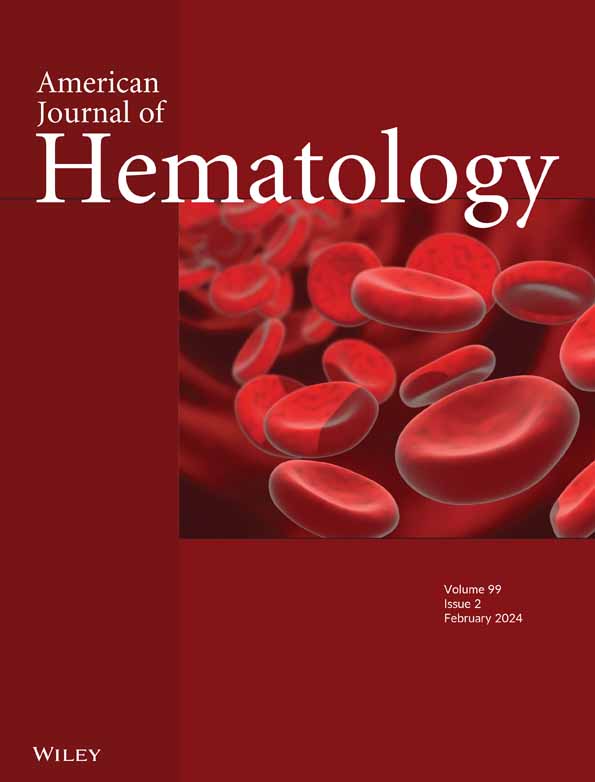Narsoplimab可提高成人和儿童造血细胞移植相关血栓性微血管病(TA‐TMA)患者的生存率
IF 9.9
1区 医学
Q1 HEMATOLOGY
引用次数: 0
摘要
不适当的补体激活是造血细胞移植相关血栓性微血管病(TA - TMA)的关键驱动因素。在一项针对成人TA - TMA患者的2期临床试验中,使用纳索普单抗(一种凝集素途径效应酶MASP‐2的抑制剂)治疗TA - TMA的有效率为61%。鉴于这些有希望的结果,建立了一个全球扩展访问计划(EAP),以促进同情使用治疗。在此,我们报告了2017年10月至2023年10月期间参加EAP的儿童(16岁)和成人(≥16岁)的生存率(n = 136)。在儿童(n = 50)中,大多数接受了同种异体HCT (n = 44);37例被认为是高危(HR), 30例(81.1%)在TA - TMA诊断时存在器官功能障碍。接受纳索普单抗作为一线治疗(n = 12)的HR TA - TMA儿童同种异体受体的1年总生存率(OS)为75.0%,接受≥二线治疗(n = 25,20对eculizumab难治)的患者为56.2%。6例接受自体HCT的实体瘤患儿1年生存率为80%。在86名成人中,84名接受了异体HCT, 65名患有HR TA - TMA,其中57名(87.7%)在诊断时患有器官功能障碍。接受纳索普单抗作为一线治疗的同种异体成人HR TA - TMA患者(n = 49)的1年OS为58.0%,接受纳索普单抗作为≥二线治疗的患者(n = 16)的1年OS为40.5%。没有任何有关安全的信号。在这项真实世界的研究中,儿童和成人的严重TA - TMA患者的生存率都很好,这支持了纳索普单抗的使用。本文章由计算机程序翻译,如有差异,请以英文原文为准。
Narsoplimab Results in Excellent Survival in Adults and Children With Hematopoietic Cell Transplant Associated Thrombotic Microangiopathy (TA‐TMA)
Inappropriate complement activation is a key driver of hematopoietic cell transplant‐associated thrombotic microangiopathy (TA‐TMA). Treatment with narsoplimab, an inhibitor of MASP‐2, the effector enzyme of the lectin pathway, resulted in a response rate of 61% in a Phase 2 clinical trial in adults with TA‐TMA. Given these promising results, a global expanded access program (EAP) was established facilitating compassionate use treatment. Herein, we report the survival of children (< 16 years old) and adults (≥ 16 years old) enrolled in the EAP from October 2017 to October 2023 (n = 136). Among children (n = 50), the majority underwent allogeneic HCT (n = 44); 37 were considered high‐risk (HR) and 30 (81.1%) had organ dysfunction at the time of TA‐TMA diagnosis. One‐year overall survival (OS) in pediatric allogeneic recipients with HR TA‐TMA who received narsoplimab as first‐line therapy (n = 12) was 75.0% and 56.2% in those who received treatment as ≥ second‐line (n = 25, 20 refractory to eculizumab). One‐year OS in the six children with a solid tumor who underwent an autologous HCT was 80%. Among the 86 adults, 84 received an allogeneic HCT, 65 had HR TA‐TMA and, among them, 57 (87.7%) had organ dysfunction at diagnosis. One‐year OS in allogeneic adults with HR TA‐TMA who received narsoplimab as first line therapy (n = 49) was 58.0%, and 40.5% in those who received narsoplimab as ≥ second line therapy (n = 16). There were no concerning safety signals. In this real‐world study enriched with patients with severe TA‐TMA, survival was excellent in children and adults, supporting the use of narsoplimab.
求助全文
通过发布文献求助,成功后即可免费获取论文全文。
去求助
来源期刊
CiteScore
15.70
自引率
3.90%
发文量
363
审稿时长
3-6 weeks
期刊介绍:
The American Journal of Hematology offers extensive coverage of experimental and clinical aspects of blood diseases in humans and animal models. The journal publishes original contributions in both non-malignant and malignant hematological diseases, encompassing clinical and basic studies in areas such as hemostasis, thrombosis, immunology, blood banking, and stem cell biology. Clinical translational reports highlighting innovative therapeutic approaches for the diagnosis and treatment of hematological diseases are actively encouraged.The American Journal of Hematology features regular original laboratory and clinical research articles, brief research reports, critical reviews, images in hematology, as well as letters and correspondence.

 求助内容:
求助内容: 应助结果提醒方式:
应助结果提醒方式:


